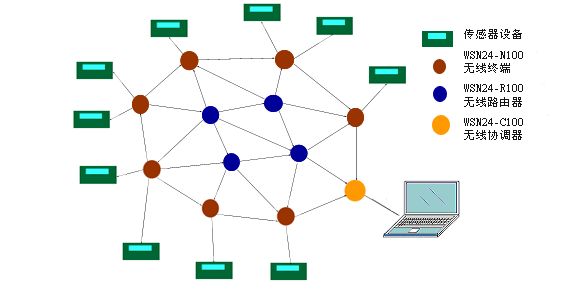Shenyang University of Technology, Wu Ruirui, Liu Jielin
Introduction
Wireless Sensor Networks (WSN) are self-organizing networks composed of numerous sensor nodes. These sensor nodes not only sense environmental information within the network but also possess simple computational capabilities, allowing them to transmit the relevant information after sensing and processing. Sensor nodes are the most crucial components of WSN, serving as the foundation of the entire network, with functions for sensing data, processing data, storing data, and transmitting data. Sensor nodes are responsible for sensing environmental information within the network, collecting monitoring data, and reporting it to user nodes via aggregation nodes.

Compared to other wireless communication networks, WSN has its own significant characteristics.
Scalability: The scalability of sensor networks has two meanings. One is deploying sensor nodes in large monitoring areas, such as forests and mountainous regions, to monitor fires or conduct other environmental monitoring activities; the other is deploying a high density of sensor nodes in a limited area.
Self-organization: WSN is a distributed self-organizing wireless network without central control, composed of peer nodes. This distributed structure can better adapt to changes in the network, automatically configuring and managing itself when changes occur, providing strong flexibility and practicality.
Multi-hop Routing: Due to the large monitoring range of WSN, the data transmission distance between sensor nodes can be very long. Therefore, multi-hop routing is often used, allowing each node to have routing forwarding capabilities, which can reduce the transmission power of nodes and lower network energy consumption.
Robustness: WSN is often applied in harsh outdoor environments such as mountains and forests, where maintaining sensor nodes can be challenging. Therefore, the network needs to have a certain level of robustness. When some nodes cannot function normally due to environmental interference or battery depletion, other nodes in the network can automatically adjust to ensure the normal operation of the WSN.
1 Applications of Wireless Sensor Networks
As one of the three pillars of information technology, WSN has been widely applied in the industrial market due to its low cost, low power consumption, and high applicability. Its main application areas are concentrated in the following aspects.
1.1 Military Reconnaissance
WSN can meet the real-time and accuracy requirements for information acquisition in various military scenarios, sensing the battlefield situation. In military applications, numerous sensor nodes are deployed in battlefield areas via aircraft to form a self-organizing network, where each node senses battlefield information and collects and transmits this data to provide intelligence for combat troops. Due to the dense and random distribution of WSN, it plays a significant role in monitoring friendly troop strength, equipment supplies, ammunition allocation, and war damage assessment; monitoring battlefield conditions, reconnaissance of enemy forces, and target tracking; detecting and investigating biochemical attacks, etc.
The United States was the first to conduct WSN research, starting with the ‘Tropical Tree’ sensors used to detect supply trucks during the Vietnam War. The U.S. has invested significant human, material, and financial resources into WSN research and has successfully applied it in military fields. Additionally, WSN can also be applied to homeland security and border monitoring.
1.2 Environmental Monitoring
With increasing attention to environmental issues, environmental monitoring has become one of the important applications of wireless sensor networks. Currently, traditional environmental monitoring methods can no longer meet human needs due to societal development and natural changes, making the use of sensor nodes for collecting, analyzing, and monitoring indoor and outdoor environments particularly important.
Given the characteristics of sensor networks, they provide convenience for monitoring outdoor environments. By collecting vibration and infrasound information through WSN, volcanic eruptions can be monitored with early warnings issued; WSN can also be used for animal tracking and migratory bird studies by observing animal behavior; deploying wireless sensor networks on plants can monitor tree growth and collect photosynthesis information, providing relevant data for plant research; deploying sensor nodes in unattended areas allows for continuous monitoring, filling monitoring blind spots to obtain more comprehensive environmental data.
With the vigorous development of science and technology, monitoring indoor environments has also become necessary. The deployment of wireless sensor systems can not only monitor real-time temperature, humidity, and air quality indoors to improve the indoor environment.
1.3 Smart Homes
Smart homes connect security systems, lighting systems, air conditioning systems, and other household appliances through IoT technology to achieve automated and intelligent management. By embedding sensor nodes in household appliances and integrating them with wireless networks and the internet, remote control of appliances can be achieved, while also monitoring household safety in real-time, making life more comfortable and convenient.
Microsoft’s ‘Future Home’ is the most advanced representation of smart homes, integrating access control systems that can monitor the home environment and detect the owner’s health status through touch, providing corresponding health tips. Fudan University, University of Electronic Science and Technology, and other institutions have also developed a WSN-based intelligent building system that can monitor household conditions through internet terminals.
1.4 Medical Health
Currently, WSN has many applications in medical systems and health care. Installing sensor nodes that can monitor heart rates or blood pressure on hospitalized patients allows doctors to understand the monitored patient’s physical condition and activity status in a timely manner. When abnormalities are detected, they can respond quickly; the sensor network-based care system can monitor elderly health issues in real-time, sensing their activities and recording their status to ensure the safety and health of the elderly, while also alleviating the burden on caregivers and improving care quality.
2 Key Technologies of Wireless Sensor Networks
2.1 Topology Control
The main function of topology control technology is data forwarding, while controlling power or neighboring nodes to achieve network coverage and connectivity. A good network topology can improve routing efficiency, reduce network energy consumption, and extend network lifespan. As a core issue in WSN, topology control can provide technical support for data fusion, routing protocols, and target localization.
Existing topology control algorithms are divided into two categories: node power control and hierarchical topology control. Power control adjusts the transmission power of sensor nodes to minimize transmission power while meeting network coverage and connectivity requirements. When the power of each node changes, the network topology also changes, reducing interference between nodes and ultimately achieving optimal connectivity. Hierarchical topology control utilizes a clustering mechanism to form cluster head nodes, with each cluster head node acting as a backbone network to divide the network into multiple clusters, allowing non-backbone nodes to temporarily stop communication to reduce network energy consumption, permitting only the backbone network to forward data.
2.2 Routing Protocols
In wireless sensor networks, network connections need to be established based on actual conditions, requiring a combination of suitable and specific algorithms and system software to create real-time dynamic connections, rather than using a pre-arranged connection method. Factors such as network bandwidth and processing power consumption are essential considerations during network operation. Therefore, when unexpected situations arise, the network can dynamically reconstruct or update the network system based on actual conditions. The reliability of communication connections between nodes is limited, and shadow fading can also be a factor affecting network connectivity. Thus, when designing routing software to meet network demands, it is crucial to carefully consider communication reliability issues.
2.3 Data Fusion
In WSN, data fusion technology can be used to process the data collected by sensor nodes, removing redundant information, saving network energy, and extending the network’s lifespan. Additionally, data fusion technology can analyze and synthesize multiple data points perceived within the network to improve information accuracy. However, data fusion technology may increase network operation time, causing delays.
2.4 Time Synchronization
Time synchronization is a key mechanism for sensor network systems that need to work collaboratively. In WSN, nodes typically need to cooperate to complete sensing and monitoring functions, requiring all nodes to maintain synchronized clocks. Existing time synchronization protocols include RBS (Reference Broadcast Synchronization), Tiny/miniSync (Micro/Mini Synchronization), and TPSN (Timing-sync Protocol for Sensor Networks).
2.5 Localization Technology
In practical applications of WSN, users are not only concerned about the sensing data from sensor nodes in the monitoring area but also wish to obtain the location information of these nodes. Thus, localization technology holds significant importance as a key technology in WSN.
In WSN, there are two types of localization methods for sensor nodes: range-based localization and range-free localization technologies. Range-based localization determines the coordinates of the node to be localized by measuring distances and angles between nodes, requiring high hardware specifications for accurate localization. Range-free localization obtains the final coordinates of the node to be localized based on connectivity between nodes in the network, which reduces hardware requirements and lowers network costs, but results in lower localization accuracy.
3 Conclusion
Through in-depth research on WSN, people’s understanding of it has deepened, and significant progress has been made in related technologies, leading to widespread applications of WSN. WSN is currently a professional research hotspot across various fields both domestically and internationally, and it is expected to become a widely used network in future society, possessing great research value and development prospects.
Recommended Training:
From September 28 to 30, 2018, a “MEMS Industry Engineer Advanced Training Course” hosted by MEMS Consulting will be held in Suzhou, where renowned instructors will share their experiences. The training content is diverse: (1) Insights from MEMS development to NEMS, focusing on MEMS research and industrialization; (2) Popular MEMS devices and their applications, including accelerometers, gyroscopes, MEMS microphones, pressure sensors, gas sensors, infrared sensors, etc.; (3) MEMS packaging and testing, covering both device-level and wafer-level aspects; (4) MEMS manufacturing processes, combined with typical MEMS device cases; (5) Visit to MEMS production lines: Suzhou MEMS pilot platform and Jieyanxin MEMS packaging production line.
For details and registration, please contact:
MEMS Consulting Contact: Peng Lin Phone: 17368357393 Email: [email protected]
